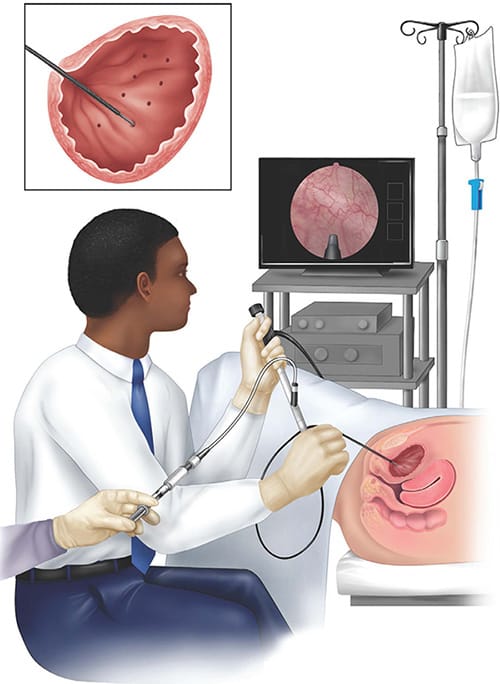Botox® Injections to Improve Bladder Control
What is Botox?
A drug made from a toxin produced by bacteria called botulinum toxin.
How does it work?
Botox can be used to treat some muscular conditions (as well as cosmetically to treat wrinkles) by temporarily paralyzing the muscle.
Involuntary contraction of the detrusor muscle (also known as the bladder wall muscle) can lead to symptoms such as urinary incontinence, urgency, and frequency. Botox causes the detrusor to relax, giving you more time to make it to the toilet without leaking because your bladder can hold more urine.
It does not work immediately and can take several days to two weeks until you experience relief from urgency urinary incontinence (UUI).
How the procedure is done
 Botox injections are usually performed in your provider's office. You can eat and drink normally on the day of the procedure. The actual procedure takes about 20 minutes. However, the entire visit may require one – two hours. When you arrive, you'll need to give a urine sample to check for signs of a UTI. If you have a UTI, the procedure will need to be rescheduled. If you have symptoms of a UTI at home, call the office right away.
Botox injections are usually performed in your provider's office. You can eat and drink normally on the day of the procedure. The actual procedure takes about 20 minutes. However, the entire visit may require one – two hours. When you arrive, you'll need to give a urine sample to check for signs of a UTI. If you have a UTI, the procedure will need to be rescheduled. If you have symptoms of a UTI at home, call the office right away.
Similar to a pelvic exam, after you've undressed from the waist down, your provider will clean your genital area with an antiseptic solution, a numbing gel may be inserted into the urethra prior to the procedure. You may also be given an antibiotic to take by mouth. Next, the provider will use a cystoscope, or lighted camera, to visualize the inside of your bladder. A thin needle will be used to inject very small amounts of a Botox solution into your bladder muscle at 10 to 30 sites. Most women do not find this painful.
Before you go home, you'll be asked to urinate. Sometimes the injections cause difficulty emptying the bladder. If this happens, you may need to use a catheter. Your provider will teach you how to catheterize yourself, or to care for a catheter that remains in place until it is removed.
After the procedure
You may resume your normal activities immediately after the procedure, including going back to work. You may drive yourself or have someone drive for you. For the first few days after, you may feel the need to urinate more frequently, notice stinging or burning when you urinate, and blood in your urine. This may be treated with an over-the-counter medicine, or you can try putting a warm or cool, damp washcloth over your genital area to relive discomfort.
Call your provider's office if you experience any of the following symptoms:
- Trouble urinating or a sense that the bladder isn't emptying.
- Heavy bleeding, including bright red colored urine or large clots in the urine.
- Burning with urination, changes to the color or smell of urine, or chills and fever (greater than 101 degrees Fahrenheit).
- Trouble breathing, confusion, disorientation, or agitation.
Who is Botox for?
Your provider may suggest Botox for UUI or overactive bladder if other treatments were not effective. The success rate for Botox ranges from 60-90 percent for UUI and its symptoms.
Who isn't Botox for?
Women who are pregnant or have certain neurologic or muscular disorders.
How long does Botox last?
Long-term relief can come from a single injection, but most women find it slowly wears off between three and 12 months. Treatment may be repeated.
Are there any risks?
Like most treatments, Botox has risks. Discuss these with your provider before the procedure. Ask your provider if you should continue any bladder medicines you are taking before the procedure.